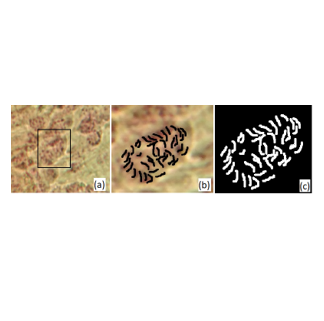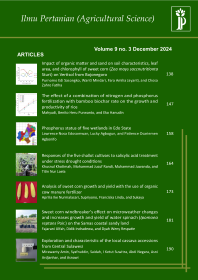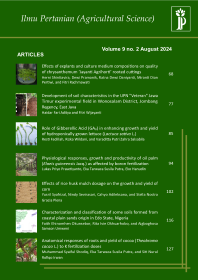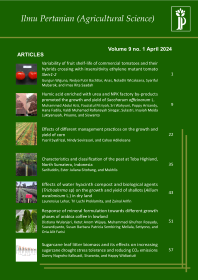
Chromosome status and yield characteristics of soybean (Glycine max L. (Merr)) in saline soil as affected by induced mutation
Agus Pernando Simanjuntak(1), Diana Sofia Hanafiah(2*), Luthfi Aziz Mahmud Siregar(3)
(1) Department of Agrotechnology, Faculty of Agriculture, Universitas Sumatera Utara Jl. Dr. A. Sofian No.3, Padang Bulan, Kec. Medan Baru, Kota Medan, North Sumatera 20155, Indonesia
(2) Department of Agrotechnology, Faculty of Agriculture, Universitas Sumatera Utara Jl. Dr. A. Sofian No.3, Padang Bulan, Kec. Medan Baru, Kota Medan, North Sumatera 20155, Indonesia
(3) Department of Agrotechnology, Faculty of Agriculture, Universitas Sumatera Utara Jl. Dr. A. Sofian No.3, Padang Bulan, Kec. Medan Baru, Kota Medan, North Sumatera 20155, Indonesia
(*) Corresponding Author
Abstract
To fulfill the demand of soybeans, the expansion of the planting area can be one of the choices through the conversion of marginal land by utilizing suboptimal land, such as saline soil. One of the plant breeding techniques to obtain tolerant plants to salinity is the use of chemical mutations, such as colchicine. The study aimed to reveal the effect of salinity on the characters of soybean plants (mutated with colchicine) and the effect of colchicine on the number of chromosomes and ploidy level. This study was conducted from January to March 2020 and carried out in the plastic house of Faculty of Agriculture, Universitas Sumatera Utara. The experiment was arranged in a Randomized Block Design with salinity levels (0 dS.m-1, 2 dS.m-1, 4 dS.m-1, 6 dS.m-1) as treatments and consisted of ten replications in each treatment. The result showed that the soybean plants were not successfully induced by colchicine at a concentration of 0.04 % with soaking duration of 10 hours, as indicated by the number of chromosomes and analysis of ploidy level. The soybeans that had been induced were planted in saline soil. There were significant effects observed on the productive branch, number of filled pods, and the weight of seeds per plant. Colchicine treatment did not successfully affect the number of chromosomes of soybeans but had an impact on the chromosome pattern. In addition, the salinity treatment of 4 dS.m-1 significantly affected the number of filled pods compared to the treatment of 6 dS.m-1.
Keywords
Full Text:
PDFReferences
Abbasi, G.H., Akhtar, J., Ahmad, R., Jamil, M., Anwar-ul-Haq, M., Ali, S., and Ijaz, M. (2015). Potassium application mitigates salt stress differentially at different growth stages in tolerant and sensitive maize hybrids. Plant Growth Regul., 76, pp. 1-15.
Afzal, I., Basra, S.M.A., and Iqbal, A. (2005). The effects of seed soaking with plant growth regulators on seedling vigor of wheat under salinity stress. J. Stress Physio. and Biochem., 1(1), pp. 6-14.
Agam, M.G.S.A.S., Kusmiyati, F., and Herwibawa, B. (2020). Diversity analysis in soybean (Glycine max (L.) Merrill) mutant lines grown in saline soils using agronomic traits and RAPD markers. IOP Conf. Ser.: Earth Environ. Sci., 482, pp. 012017.
Deinlein, U., Stephan, A. B., Horie, T., Luo, W., Xu, G., and Schroeder, I. J. (2014). Plant salt-tolerance mechanisms. Trends in Plant Sci., 19(6), pp. 371-379.
Dhooghe, E., Van Laere, K., Eeckhaut, T., Leus, L., and Van Huylenbroeck, J. (2011). Mitotic chromosome doubling of plant tissues in vitro. Plant Cell Tiss. Organ Cult., 104, pp. 359-373.
Frederick, J.R., Camp, C.R., and Bauer, P.J. (2001). Drought-stress effects on branch and mainstem seed yield and yield components of determinate soybean. Crop Sci., 41(3), pp. 759–763.
Hakim, L. (2012). Komponen hasil karakter morfologi penentu hasil kedelai. J. Penelitian
Pertanian Tanaman Pangan, 31(3), pp. 73-179.
Ismail, M., Yudono, P., and Waluyo, S. (2018). Tanggapan dua kultivar kedelai (Glycine max L.) terhadap empat aras salinitas. Vegetalika, 7(2), pp. 16-29.
Suda, J., Kron, P., Husband, B.C., and Trávníĉek, P. (2007). Flow cytometry and ploidy: Applications in plant systematics, ecology and evolutionary biology. In: J. Dolezel, et al., eds., Flow Cytometry with Plant Cell. 1st ed. Weinheim: WILEY-VCH Verlag GmbH and Co. KgaA, pp 103-130.
Leung, Y.Y., Hui, L.L.Y., and Kraus, V.B. (2015). Colchicine-update on mechanisms of action and therapeutic uses. Semin Arthritis Rheum., 45(3), pp. 341-350.
Martinez-Ballesta, M.D. and Carjaval, M. (2014). New challenges in plant aquaporin biotechnology. Plant Sci., 217-218, pp. 71-77.
Mangena, P. (2020). In vivo and in vitro application of colchicine on germination and shoot
proliferation in soybean (Glycine max (L.) Merr.). Asian J. Crop Sci., 12(1), pp. 34-42.
Manzoor, A., Ahmad, T., Bashir, M. A., Hafiz, I. A. and Silvestric, C. (2019). Studies on colchicine induced chromosome doubling for enhancement of quality traits in ornamental plants. Plants, 8(7), pp. 194.
Ministry of Agriculture Republic Indonesia. (2017). Strategi pencapaian swasembada kedelai 1st ed. Bogor: Kementerian Pertanian Republik Indonesia, pp 45-50.
Mostafa, G.G. and Alhamd, M.F.A. (2016). Detection and evaluation the tetraploid plants (Celosia argantea) induced by colchicines. Int. J. Plant Breed. Genet., 10(2), pp. 110-115.
Niu, L., Yan-Bin, T., Mao-Sheng, C., Qiantang, F., Yuling, D., Huiying, H., and Zeng-Fu, X. (2016). Identification and characterization of tetraploid and octoploid Jatropha curcas induced by colchicine. Carylogia: Int. J. of Cytology, Cytosystematic and Cytogenetics, 60(1), pp. 58-66.
Rishi, A. and Sneha, S. (2016). Antioxidative defence against reactive oxygen species in plants under salt stress. Int. J. Curr. Res., 5(7), pp. 1622-1627.
Rosmayati, Rahmawati, N., Astari, R.P., and Wibowo, F. (2015). Analisa pertumbuhan vegetatif kedelai hibridisasi genotipa tahan salin dengan varietas anjasmoro untuk mendukung perluasan areal tanam di lahan salin. Jurnal Pertanian Tropik, 2(17), pp. 132-139.
Parihar, P., Singh, S., Singh, R., Singh, V.P., and Prasad, S.M. (2015). Effect of salinity stress on plants and its tolerance strategies; a review. Env. Sci. And Pollution Research, 22(6), pp. 4056-4075.
Tidke, S.A., Ramakrishna, D., Kiran, S., Kosturkova, G., and Ravishankar, G.A. (2015). Nutraceutical potential of soybean: Review. Asian Journal of Clinical Nutrition, 7(2), pp. 22-32.
Ślusarkiewcz-Jarzina, A., Pudelska, H., Woźna, J., and Pniewski, T. (2017). Improved production of doubled haploids of winter and spring triticale hybrids via combination of colchicine treatments on anthers and regenerated plants. J. Appl. Genet., 58(3), pp. 287-295.
Subramanyam, K., Arun, M., Mariashibu, T.S., Theboral, J., Rajesh, M., Singh, N.K., Manickavasagam, M., and Ganapathi, A. (2012). Overexpression of tobacco osmotin (TBOSM) in soybean conferred resistance to salinity stress and fungal infections. Planta, 236, pp. 1909-1925.
Takahira, J., Cousin, A., Nelson, M.N., and Cowling, W.A. (2011). Improvement in efficiency of microspore culture to produce doubled haploid canola (Brassica napus L.) by flow cytometry. Plant Cell Tiss. Organ Cult., 104(1), pp. 51-59.
Wardhani, M. and Wiendi, N.M.A. (2015). Induksi mutasi genetik melalui penggandaan kromosom kedelai (Glycine max (L.) Merr.) varietas wilis tanggamus dengan kolkisin secara in vitro. Prosiding Simposium Seminar Bersama PERAGI-PERHORTI-PERIPI-HIGI mendukung kedaulatan pangan energi yang berkelanjutan, pp. 274-280.
Zhou, K., Fleet, P., Nevo, E., Zhang, X., and Sun, G. (2017). Transriptome analysis reveals plant response to colchicine treatment during on chromosome doubling. Sci. Rep., 7(8503), pp. 1-11.
Article Metrics
Refbacks
- There are currently no refbacks.
Ilmu Pertanian (Agricultural Science) ISSN 0126-4214 (print), ISSN 2527-7162 (online) is published by Faculty of Agriculture Universitas Gadjah Mada collaboration with Perhimpunan Sarjana Pertanian Indonesia (PISPI) and licensed under a Creative Commons Attribution-ShareAlike 4.0 International License.













